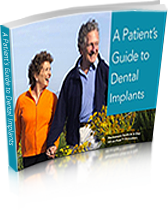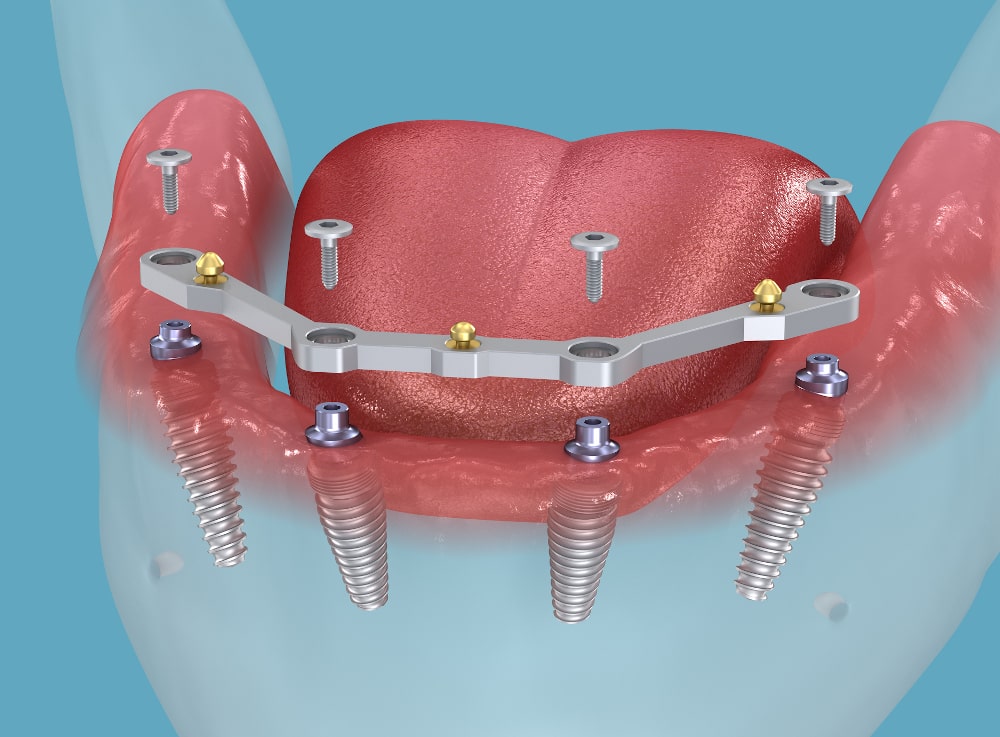
Key Takeaways
- All-on-4 and All-on-6 dental implants are full-arch tooth replacement options that use 4 or 6 implants per arch, respectively.
- All-on-4 is often suitable for patients with reduced bone density, while All-on-6 provides increased stability and support for long-term outcomes.
- Both procedures follow a structured process, consisting of consultation, surgery, healing, and aftercare.
- Key differences lie in the number of implants, support level, prosthetic stability, and potential longevity.
- Expert opinions suggest that individual patient needs dictate the most appropriate solution.
What are All-on-4 and All-on-6 dental implants?
Dental implants have revolutionized restorative dentistry by offering permanent solutions for missing teeth. Among the most common full-arch options are the All-on-4 and All-on-6 dental implant systems. While they share similarities, understanding the nuances of each is essential for informed decision-making.
All-on-4 Dental Implants
The All-on-4 method uses four strategically placed titanium implants per arch — two straight implants in the front and two angled implants in the back — to support a fixed prosthesis. This approach maximizes available bone and often eliminates the need for bone grafting.
Typical Use Case:
- Patients with significant bone loss
- Those seeking quicker recovery and lower treatment costs
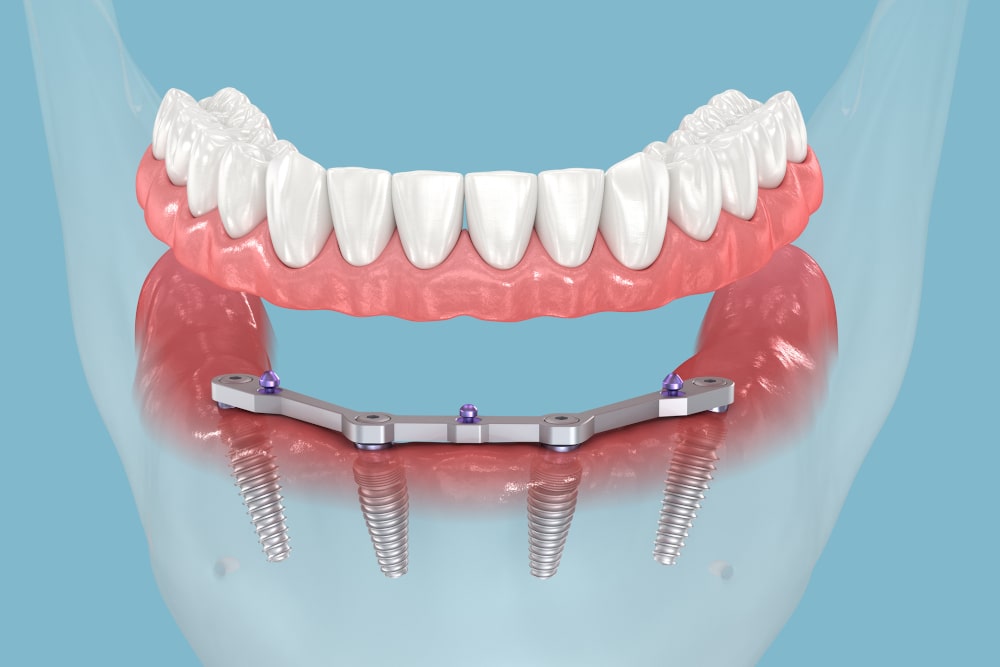
All-on-6 Dental Implants
The All-on-6 procedure involves placing six implants per arch, all of which are placed vertically to support the prosthesis. This system offers greater strength and load distribution, making it suitable for patients who have better bone density.
Typical Use Case:
- Patients with sufficient jawbone volume
- Individuals requiring enhanced prosthetic stability
Specification Table
| Feature | All-on-4 | All-on-6 |
|---|---|---|
| Number of implants | 4 per arch | 6 per arch |
| Implant angulation | Posterior implants angled | All implants vertical |
| Bone graft requirement | Rarely needed | Occasionally needed |
| Prosthetic stability | Good | Superior |
| Load distribution | Moderate | Excellent |
| Cost | Lower | Higher |
| Longevity (estimated) | 10–15 years | 15–20+ years |
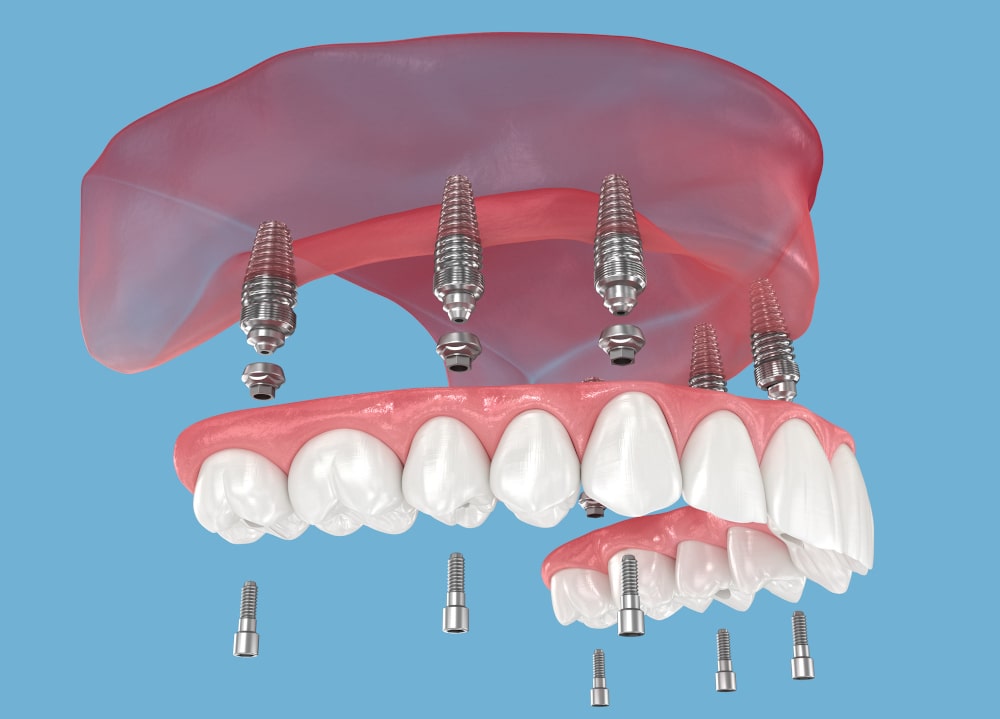
How does the All-on-6 dental implant procedure work step by step?
The All-on-6 dental implant treatment is a well-orchestrated process that spans consultation, surgery, healing, and post-procedural care. Precision and planning are crucial at every stage.
Step 1: Initial Consultation and Assessment
The process begins with a comprehensive evaluation:
- 3D CT scans and digital impressions are used to assess bone quality and density
- A full medical and dental history is taken.
- Treatment planning includes prosthetic design and implant placement strategy.
Step 2: Treatment Planning
At this stage, a digital simulation of implant placement is created. The surgical plan includes:
- Optimal locations for the 6 implants
- Assessment of sinus cavities and nerve pathways
- Consideration of bone grafting, if needed
Step 3: Implant Surgery
This is the core of the procedure:
- Local anesthesia or IV sedation is administered
- Six implants are inserted into the jawbone at predetermined locations.
- A temporary prosthesis may be placed on the same day (immediate load)
Step 4: Osseointegration (Healing Phase)
Over the next 3–6 months:
- Bone tissue integrates with the implant surface, forming a stable foundation
- Patients are advised on diet, hygiene, and care routines.
Step 5: Final Prosthetic Placement
Once healing is complete:
- The temporary bridge is removed
- A custom-milled permanent prosthetic is attached.
- Final adjustments are made for bite alignment and aesthetics.
Step 6: Aftercare and Maintenance
Long-term success relies heavily on post-op care:
- Regular dental check-ups (every 6–12 months)
- Proper brushing and flossing techniques
- Avoidance of hard foods in early recovery
Dr. Amir Guorgui, BSc, DMD, MACSD, emphasizes: “All-on-6 is ideal for patients seeking the most stable long-term option. The additional implants increase durability and prosthetic support, which can make a significant difference over time.”
What are the structural and functional differences between All-on-4 and All-on-6?
While both systems aim to restore full arches, key architectural and biomechanical differences exist between All-on-4 and All-on-6 dental implants.
Structural Differences
- Implant Count: All-on-4 uses four implants, while All-on-6 uses 6, distributing the force more evenly.
- Implant Positioning: All-on-4 utilizes angled posterior implants to minimize the need for bone grafts. All-on-6 relies on vertical placement, often needing more bone volume.
- Prosthesis Design: All-on-6 often allows for a wider arch and more teeth due to increased implant support.
Functional Differences
- Support and Stability: More implants mean better load distribution in All-on-6, reducing pressure on individual implants.
- Bone Preservation: All-on-4 is suitable for individuals with bone loss, while All-on-6 can help prevent future bone resorption due to its broader distribution.
- Longevity: All-on-6 may offer increased longevity and a lower risk of implant failure, although both systems are durable.
Comparison Table
| Feature | All-on-4 | All-on-6 |
|---|---|---|
| Structural Support | Moderate | Superior |
| Suitable for Low Bone Volume | Yes | Less so |
| Risk of Overload on Implants | Higher due to fewer implants | Lower due to wider distribution |
| Prosthesis Flexibility | Moderate | High |
| Long-term Stability | Good | Excellent |
Dr. James C.H. Ko, DDS, notes: “Choosing between All-on-4 and All-on-6 isn't just about numbers — it’s about the patient’s anatomy, functional needs, and long-term goals. A tailored approach is always best.” [Source: allonfourdentalimplants.ca]
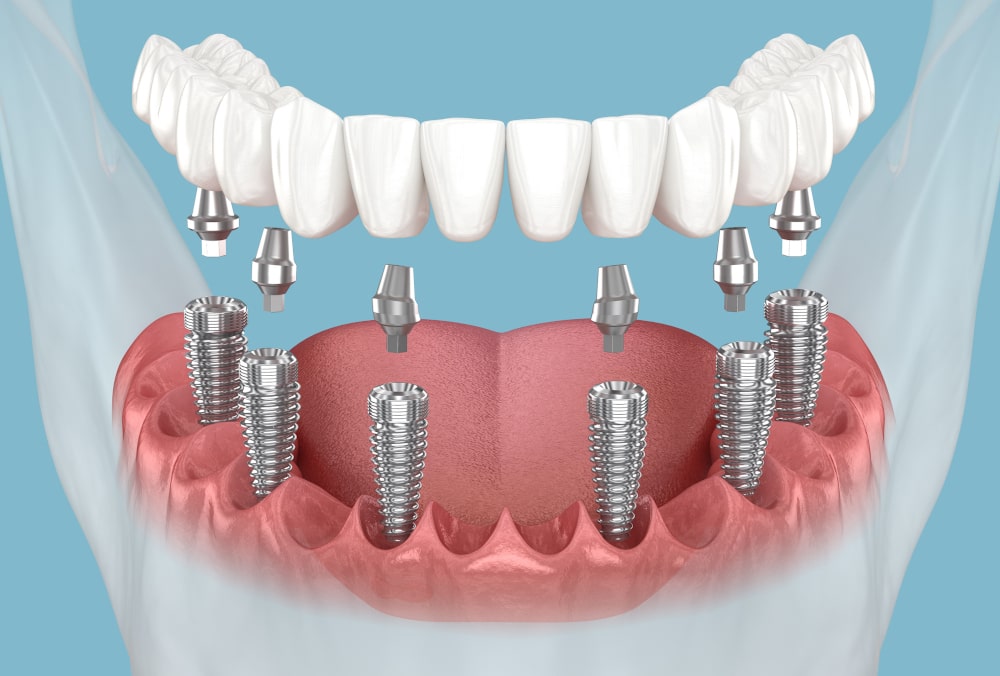
Is there a significant cost difference between All-on-4 and All-on-6 dental implants?
Yes, the cost difference between these two implant systems can be significant. Pricing depends on multiple factors, including the number of implants, materials used, and the complexity of the procedure.
Cost Breakdown by Component
| Factor | All-on-4 | All-on-6 |
|---|---|---|
| Number of implants | 4 | 6 |
| Average treatment cost (CAD) | $20,000–$26,000 per arch | $28,000–$35,000 per arch |
| Implant material | Titanium | Titanium |
| Prosthetic type | Acrylic or Zirconia | Acrylic or Zirconia |
| Surgical complexity | Moderate | High |
| Anesthesia | Local or sedation | Often IV sedation |
| Follow-up appointments | 2–3 | 3–5 |
Why All-on-6 Costs More
- More implants = more surgical time and materials
- A greater number of follow-ups and adjustments
- Potential need for bone grafts in some cases
Which implant type is more suitable for bone loss cases?
The answer is clear: All-on-4 dental implants are generally more suitable for patients with significant bone loss. The system was explicitly designed to maximize use of the existing bone structure and to avoid bone grafts whenever possible.
Bone Grafting Considerations
- All-on-4 utilizes angled posterior implants that bypass sinus cavities and nerves, thereby minimizing the need for grafting.
- All-on-6 requires vertical alignment, which often necessitates more bone volume or a bone graft.
Expert Insight
"We often recommend All-on-4 for patients with moderate to severe bone resorption. It's less invasive and eliminates the need for grafting in most cases," says Dr. James C.H. Ko, DDS.
How do recovery times compare between All-on-4 and All-on-6 procedures?
While both procedures involve similar recovery phases, All-on-4 typically allows for a faster and less complex recovery due to fewer implants and a less invasive approach.
General Healing Timelines
- All-on-4: Initial healing in 1–2 weeks; full osseointegration in ~3 months
- All-on-6: Initial healing in 2–3 weeks; full osseointegration in 4–6 months
Pain and Discomfort
- Both procedures involve minor swelling and soreness post-op.
- Pain typically subsides within 3–5 days, managed with over-the-counter medication.
Diet and Activity Recommendations
- First week: Soft, non-chewy foods (soups, smoothies, scrambled eggs)
- Weeks 2–6: Gradual return to solid foods
- Avoid: Hard, crunchy, or spicy foods during the early recovery period.
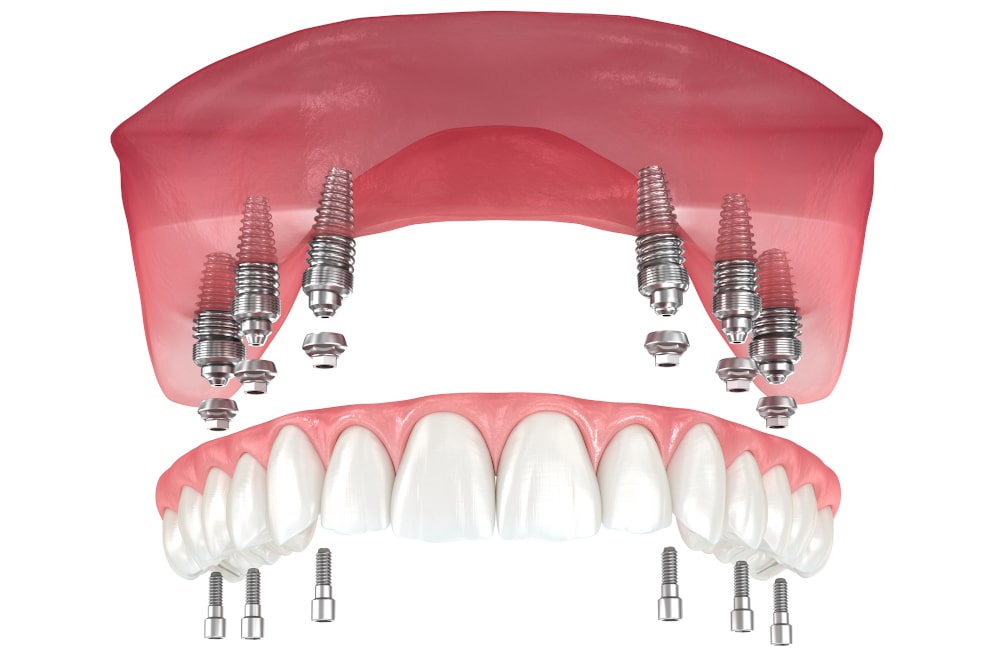
Do more implants mean better durability and long-term success?
In general, yes — more implants can enhance the durability and long-term success of full-arch restorations. However, success depends not just on quantity but also on placement, bone quality, and patient care.
Implant Lifespan and Performance
- Clinical studies report implant survival rates of over 95% at 10 years for both systems.
- All-on-6 may offer enhanced load distribution, which reduces mechanical stress on individual implants.
- More implants can also reduce the risk of prosthetic fractures or screw loosening over time.
Maintenance Considerations
Regardless of implant count:
- Good oral hygiene and regular dental check-ups are critical
- Patients must avoid habits like smoking or teeth grinding.
- Proper maintenance can extend implant life well beyond 15 years.
What are the pros and cons of All-on-4 and All-on-6 implants?
Both All-on-4 and All-on-6 systems offer effective, full-arch tooth restoration — but with trade-offs. Here’s a summary of the key advantages and limitations.
Comparison Table
| Feature | All-on-4 Implants | All-on-6 Implants |
|---|---|---|
| Pros | - Suitable for patients with bone loss | - Superior stability and support |
| - Lower cost | - Better load distribution | |
| - Shorter surgery and healing time | - Longer lifespan potential | |
| - Less invasive procedure | - Stronger prosthesis durability | |
| Cons | - Slightly higher risk of implant overload | - More costly |
| - May not be suitable for high bite forces | - Requires more bone volume | |
| - Limited prosthetic flexibility | - Longer surgical time |
How to choose the correct procedure: All-on-4 or All-on-6?
Choosing between All-on-4 and All-on-6 dental implants is not just a technical decision — it’s a highly personal one. Each patient brings unique anatomical, financial, and lifestyle considerations to the table.
Key Patient Factors to Consider
| Factor | All-on-4 Recommended If... | All-on-6 Recommended If... |
|---|---|---|
| Age | Over 60 or medically compromised | Younger or in good systemic health |
| Bone health | Moderate to significant bone loss | Adequate jawbone density and volume |
| Budget | Seeking a more affordable solution | Can invest in higher upfront cost |
| Lifestyle | Prefers quicker treatment and recovery | Wants the most secure, long-lasting result |
| Aesthetic demands | Standard expectations | High-demand aesthetics and durability |
Which dental implant option is right for you?
Both All-on-4 and All-on-6 implants are proven full-arch solutions; however, their suitability depends on your individual anatomy, expectations, and financial situation.
Summary Table
| Criteria | All-on-4 | All-on-6 |
|---|---|---|
| Implant Count | 4 | 6 |
| Cost | Lower | Higher |
| Bone Graft Requirement | Rare | Sometimes needed |
| Healing Time | Shorter | Slightly longer |
| Long-Term Durability | Good | Excellent |
| Aesthetic Outcome | Satisfactory | High-end |
| Ideal For | Low bone density, tight budgets | Stable bone structure, long-term focus |


